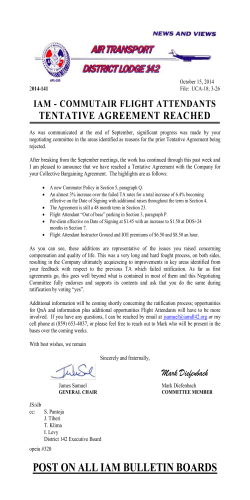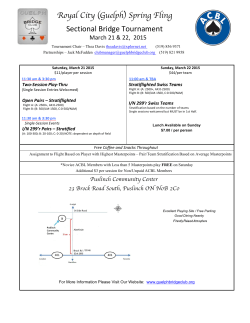
Aircraft IT Operations eJournal
34 | WHITE PAPER: PACE | AIRCRAFT IT OPERATIONS | FEBRUARY/MARCH 2015 En-Route Flight Profile Optimization Airlines can achieve significant savings through task-specific software which determines in real time the most cost-efficient flight trajectory (ECON) in all phases of the flight operation, says Dr. Oliver Kranz, Managing Partner at PACE. FEBRUARY/MARCH 2015 | AIRCRAFT IT OPERATIONS | WHITE PAPER: PACE | 35 S ometimes, when discussing a technology that might be new to some people, it is useful to start by looking at a similar technology with which most people will be familiar. Readers will be familiar with the global positioning system (GPS) for everyday use in their cars. While GPS was originally simply an aid for getting from A to B, today it is pretty smart and there are systems available to help optimize your route in terms of both arriving at your destination in good time and getting there as efficiently as possible. WHAT CAN CHANGE DURING THE FLIGHT? Continuing with this line of thought, now, let’s take a look at our particular area of interest, aircraft operations IT: are we at the same point of development in the cockpit as we are in the car? The answer has to be that we are not. While GPS-based car Satnav driver assistance systems have evolved from ‘getting there’ to ‘getting there on time and with maximum efficiency’, the functionality available to flight crews still lags behind. And this despite the fact that, in a fiercely competitive market with narrow profit margins, it is far more important for airlines to control operational efficiency than it is for even the most cost-conscious driver. In order to maximize operational efficiency, flight crews must aim to operate as closely to the optimum flight path as possible. However, even during a routine flight, many factors directly influencing the vertical flight profile may change, including: • Changing wind conditions; • Newly available, blocked or restricted flight level (FL); • Connection changes for passengers; • Air traffic control (ATC) directive, such as detour or speed restrictions; • New ‘latest time on position’ (LTOP) to serve all connecting flights; INTERACTIVE Click here for full product details “…the functionality available to flight crews still lags behind. And this is despite the fact that, in a fiercely competitive market with narrow profit margins, it is far more important for airlines to control operational efficiency…” • Significant meteorological information (SIGMET) update; So, let’s take a look at the means of flight profile optimization currently available on board and how they reflect these changing conditions. The main sources of optimum flight path information today are the operational flight plan (OFP) and the flight management system (FMS). But the OFP is usually several hours old, having been calculated and filed with ATC well in advance of the flight, which carries the risk that some of the underlying assumptions may have changed even before take-off. And once airborne, the FMS’s limited computational power only allows a basic trajectory recalculation when flight conditions change. The lack of adequate technical tools and methodologies for operational efficiency management and decision support on board forces pilots to rely either on rule of thumb, gut feeling or experience gained on the job. Surely, this is not an ideal approach. FLIGHT PATH INFORMATION What flight crews need are on-board decision support tools designed specifically for flight profile optimization; tools that provide continuous optimization advice, present the most cost-efficient trajectory, or ECON, and inform about the current savings potential. Addressing this challenge, PACE developed a product called Pacelab Flight Profile Optimizer, which runs on Class 2 electronic flight bags (EFB). As the name indicates, the tool continuously determines the ECON trajectory for the current flight conditions, recommends speeds and altitudes while ensuring on-time performance and providing concise information about overall fuel burn and estimated time of arrival (ETA). At any time of the operation, flight crews are provided with at-a-glance information about the actions necessary to meet the projected savings potential. Thus, Pacelab Flight Profile Optimizer’s unique functionality creates a permanent situational awareness for pilots to help them improve their flight’s efficiency. 1% fuel average g in sav s Meet your new crew member! Pacelab Flight Profile Optimizer Pacelab Flight Profile Optimizer complements the functional scope of FMS with advanced flight profile optimization capabilities and provides invaluable economic decision support. With fuel savings of on average 1% per flight it is possible to accumulate substantial cost savings across the entire fleet and significantly increase the airline‘s EBIT. Visit us at booth E12 at the Airline & Aerospace MRO & Operations IT Conference in Miami! www.pace.de | www.pacelab.com March 24-25, 2015 36 | WHITE PAPER: PACE | AIRCRAFT IT OPERATIONS | FEBRUARY/MARCH 2015 Now you might say that the FMS provides pilots with ‘ECON’. That is correct but, over and above the FMS’s ECON mode, Pacelab Flight Profile Optimizer enables significantly more accurate and comprehensive ECON calculations. Unlike the dated on-board technology, Pacelab Flight Profile Optimizer uses superior calculation algorithms to process high-fidelity data models – such as best available aircraft performance data, live weather and operational data – for a continuous and holistic optimization of the vertical flight profile en-route. Consequently, it makes sense to complement the FMS with an EFB application like Pacelab Flight Profile Optimizer to enable state-of-the-art operational efficiency on board: The FMS focuses on ‘getting there reliably and safely’ while the software targets on ‘getting there as efficiently as possible’. Author DR. OLIVER KRANZ MANAGING PARTNER, PACE PACE managing partner Dr. Oliver Kranz heads the business unit Flight Operations, which focuses on developing and marketing innovative software solutions to improve airlines’ fuel and operational efficiency management. As one of the three co-founders of the company, Dr. Kranz was instrumental in driving the enterprise from start-up to its current status as a trusted partner of leading aerospace organizations around the world. About the company PACE SAVINGS POTENTIAL Naturally, the bottom-line savings will depend on a variety of factors, many of them airline-specific, but for the average operator we have calculated that the available saving is around 1%. While launch customer Lufthansa is currently rolling out Pacelab Flight Profile Optimizer on their intercontinental fleet of A330, A340, A380, B747-400 and B747-8 aircraft, their regional carrier Lufthansa CityLine has already reported fuel savings of on average 4% using the software for regional operations where the FMS does not support CI flying. These substantial savings are the accumulated result of quality input data, state-of-the-art optimization algorithms and taking full advantage of the EFB’s processing power. For example, while flight planning systems and the FMS use simplified performance data and temperature models, ECON calculations with Pacelab Flight Profile Optimizer are based on complex, high-fidelity data, such as… • 1st principles data, the most accurate aircraft performance data currently available; • Real-time aircraft data, including correct off-block gross weight (cf. above); • Live wind and temperature updates. The combination of high-end hardware and software allows… • Constant recalculation of the ECON flight path for the remaining route to destination; • Waypoint-independent optimization of step climbs and descents; • Inclusion of user-definable constraints into the optimization run; • Calibration of the cost index value used by the FMS, which has an aircraft type-specific offset resulting in a higher than required ECON speed; … thus providing… • A truly holistic flight path optimization; • Increased cost awareness of flight crews; • Improved operational efficiency and on-time performance. THE FINANCIAL CASE “…for the average operator the available saving is around 1%.” Of course, what matters to any business is the financial impact of any new process, the return on investment (ROI) and the impact on airline profitability. The illustration below shows a sample medium-sized airline with 100 aircraft executing 200,000 flights per year. If we assume an operating income of $100 m, the average EBIT (earnings before interest and taxes) is $500 per flight. Assuming typical fuel consumption and kerosene price, our projected 1% fuel savings would save just a little over $40 per flight. That is quite impressive when you realize that with only 1% in fuel savings it is possible to increase the earnings per flight by more than 8%, adding up to annual cost savings of over $8m across the fleet or $80,000 per aircraft. Perhaps we can close by returning to our initial example of navigation for ground vehicles. Just as the GPS-based Satnav system is standard in cars, EFB solutions like Pacelab Flight Profile Optimizer might soon become standard in the cockpit of every aircraft, exploiting the capabilities of state-of-the-art software and hardware to unlock substantial savings potential. n PACE Aerospace Engineering and Information Technology GmbH, with offices in Germany and the US, develops and distributes intelligent software solutions for aircraft and engine manufacturers, airlines, MRO providers and leasing companies supporting the entire life-cycle of the aircraft, from marketing and design to customization and flight operations. Major areas of application are conceptual aircraft and aircraft systems design, cabin configuration, performance analysis and the management of fuel and operational efficiency in flight operations. INTERACTIVE Give us your opinion Click here to post your comment INTERACTIVE Subscribe here Click here to read all future editions
© Copyright 2025









